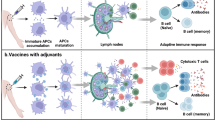Abstract
Toxoplasma gondii releases factors that potently stimulate production of interleukin-12 (IL-12) from dendritic cells (DCs). Purification of this activity showed that cyclophilin-18 (C-18) was its principal component, and antibodies generated against recombinant C-18 inhibited tachyzoite extract–induced synthesis of IL-12. Recombinant C-18 showed high affinity for and triggered cell signaling through CCR5, a chemokine receptor important in parasite-induced IL-12 production by DCs. These findings suggest that the unusual potency of T. gondii in inducing IL-12 from DCs results from its synthesis of a unique chemokine mimic that signals through CCR5. The ability to generate this strong protective response may benefit parasite transmission by preventing the protozoan from overwhelming its intermediate hosts.
This is a preview of subscription content, access via your institution
Access options
Subscribe to this journal
Receive 12 print issues and online access
$209.00 per year
only $17.42 per issue
Buy this article
- Purchase on Springer Link
- Instant access to full article PDF
Prices may be subject to local taxes which are calculated during checkout







Similar content being viewed by others
References
Trinchieri, G. Interleukin-12: a proinflammatory cytokine with immunoregulatory functions that bridge innate resistance and antigen-specific adaptive immunity. Annu. Rev. Immunol. 13, 251–276 (1995).
Yap, G.S. & Sher, A. Cell-mediated immunity to Toxoplasma gondii: initiation, regulation and effector function. Immunobiology 201, 240–247 (1999).
Sousa, C.R. et al. In vivo microbial stimulation induces rapid CD40 ligand-independent production of interleukin 12 by dendritic cells and their redistribution to T cell areas. J. Exp. Med. 186, 1819–1829 (1997).
Scanga, C.A. et al. Cutting edge: MyD88 is required for resistance to Toxoplasma gondii infection and regulates parasite-induced IL-12 production by dendritic cells. J. Immunol. 168, 5997–6001 (2002).
Aliberti, J. et al. CCR5 provides a signal for microbial induced production of IL-12 by CD8 α+ dendritic cells. Nat. Immunol. 1, 83–87 (2000).
High, K.P., Joiner, K.A. & Handschumacher, R.E. Isolation, cDNA sequences, and biochemical characterization of the major cyclosporin-binding proteins of Toxoplasma gondii. J. Biol. Chem. 269, 9105–9112 (1994).
Sherry, B., Yarlett, N., Strupp, A. & Cerami, A. Identification of cyclophilin as a proinflammatory secretory product of lipopolysaccharide-activated macrophages. Proc. Natl. Acad. Sci. USA 89, 3511–3515 (1992).
Jin, Z.G. et al. Cyclophilin A is a secreted growth factor induced by oxidative stress. Circ. Res. 87, 789–796 (2000).
Berriman, M. & Fairlamb, A.H. Detailed characterization of a cyclophilin from the human malaria parasite Plasmodium falciparum. Biochem. J. 334, 437–445 (1998).
Kofron, J.L., Kuzmic, P., Kishore, V., Colon-Bonilla, E. & Rich, D.H. Determination of kinetic constants for peptidyl prolyl cis-trans isomerases by an improved spectrophotometric assay. Biochemistry 30, 6127–6134 (1991).
Hacker, J. & Fischer, G. Immunophilins: structure-function relationship and possible role in microbial pathogenicity. Mol. Microbiol. 10, 445–456 (1993).
Ivery, M.T. Immunophilins: switched on protein binding domains? Med. Res. Rev. 20, 452–484 (2000).
Triantafilou, M. & Triantafilou, K. Lipopolysaccharide recognition: CD14, TLRs and the LPS-activation cluster. Trends Immunol. 23, 301–304 (2002).
Murphy, P.M. Viral exploitation and subversion of the immune system through chemokine mimicry. Nat. Immunol. 2, 116–122 (2001).
Berger, E.A., Murphy, P.M. & Farber, J.M. Chemokine receptors as HIV-1 coreceptors: roles in viral entry, tropism, and disease. Annu. Rev. Immunol. 17, 657–700 (1999).
Horuk, R. et al. A receptor for the malarial parasite Plasmodium vivax: the erythrocyte chemokine receptor. Science 261, 1182–1184 (1993).
Hadley, T.J. & Peiper, S.C. From malaria to chemokine receptor: the emerging physiologic role of the Duffy blood group antigen. Blood 89, 3077–3091 (1997).
Grunvald, E. et al. Biochemical characterization and protein kinase C dependency of monokine-inducing activities of Toxoplasma gondii. Infect. Immun. 64, 2010–2018 (1996).
Seeber, F. & Boothroyd, J.C. Escherichia coli β-galactosidase as an in vitro and in vivo reporter enzyme and stable transfection marker in the intracellular protozoan parasite Toxoplasma gondii. Gene 169, 39–45 (1996).
Wu, L. et al. Interaction of chemokine receptor CCR5 with its ligands: multiple domains for HIV-1 gp120 binding and a single domain for chemokine binding. J. Exp. Med. 186, 1373–1381 (1997).
Acknowledgements
We thank P. Murphy, E. Berger and H. Golding for suggestions and critical reading of this manuscript.
Author information
Authors and Affiliations
Corresponding author
Ethics declarations
Competing interests
The authors declare no competing financial interests.
Supplementary information
Supplementary Fig. 1.
Specificity control for antiserum to C-18. Recombinant C-18 molecule (C), STAg (ST) and the tachyzoite culture supernatant (SN) (1μg/lane) were separated by denaturing gel electrophoresis (4-20% gel) and subsequently transferred to PVDF membranes. The figure shows an immunoblot, using for detection rabbit antisera anti-C-18 (1499) or normal rabbit serum (NRS) at a 1:5,000 dilution. (PDF 669 kb)
Rights and permissions
About this article
Cite this article
Aliberti, J., Valenzuela, J., Carruthers, V. et al. Molecular mimicry of a CCR5 binding-domain in the microbial activation of dendritic cells. Nat Immunol 4, 485–490 (2003). https://doi.org/10.1038/ni915
Received:
Accepted:
Published:
Issue Date:
DOI: https://doi.org/10.1038/ni915
This article is cited by
-
Toxoplasmosis and abortion: pro- and anti-inflammatory cytokines gene expression of the host immune cells
Egyptian Journal of Medical Human Genetics (2019)
-
P2X7 receptor‐dependent tuning of gut epithelial responses to infection
Immunology & Cell Biology (2017)
-
Identification of microsporidia host-exposed proteins reveals a repertoire of rapidly evolving proteins
Nature Communications (2017)
-
Microbial cyclophilins: specialized functions in virulence and beyond
World Journal of Microbiology and Biotechnology (2017)
-
Dendritic cells and parasites: from recognition and activation to immune response instruction
Seminars in Immunopathology (2017)



